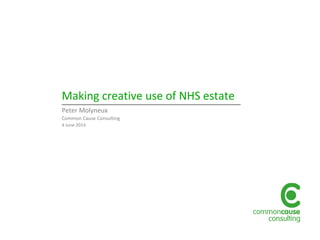Making creative use of the NHS estate
- 1. Making creative use of NHS estate Peter Molyneux Common Cause Consulting 4 June 2014
- 2. • Land surplus to requirements • Lodge with public land registry for 50 days • If NHS or other public body interested then transferred or sold at NPV. • If not marketing agent instructed and sealed bids sought. • Bids assessed and received by District Valuer • Highest bid accepted. NHS land disposal process
- 3. • Land surplus to requirements • Foundation Trusts must operate within risk assessment framework. • Decision may require approval from the Board and Council of Governors. • NHS Trusts are entitled to keep proceeds up to £5m. • Over £10m a business case is required. • Up to £50m a business case for investment must receive NHS TDA approval. • Over £50m DH and Treasury approval is required. Rules on assets
- 5. • Low financial risk • Raises fixed capital sum quickly – for investment in new facilities • Overage partly recoups uplift from development • Trust loses equity in perpetuity • Trust loses control over development and development of community infrastructure is difficult • Early sale may reduce income and cost control needs to be robust to limit risk of overrun. Release value of land at outset
- 7. • Surplus land is exchanged for new mental health facilities. • Financial certainty is delivered early – design certainty also needs to be delivered early. • Trust is not distracted from core purpose. • Financial failure of selected purchaser. • Trust is very dependent on purchaser delivering on obligations Cross-subsidy with single partner
- 9. • Selection of right partner will share burden of optimised delivery of the whole • Control maintained over timing and sequencing of the whole development and community development. • Sales values maximised. • JV structure could be used to incentivise the delivery of holistic best value. • Income at risk from market fluctuations. Single flexible partner, release in phases using open supply chain
- 11. • Selection of right partner will share burden of optimised delivery of the whole • Financial risks and workload are shared. • Opportunity to engage or involve community partners in the consortium – which can also hide / reduce value of cross subsidy. • Risk share may reduce outturn value to the Trust for cross subsidy. • Delivery of best value in discrete elements may not deliver best value overall. Consortium approach to whole of planning consent
- 12. • Housing associations should have a clear service offer that is measurable, tradeable and marketable. • Understand service transformation and CIP programmes and how they can help with them. • Understand land disposal plans of local Trusts and appetite for disposals or JVs • Understand proposals of local authority. Making an approach












